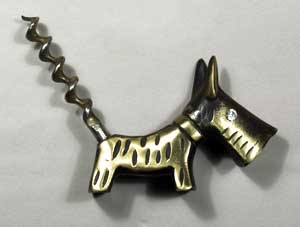UC Berkeley Press Release
Hearst dusts off corkscrew collection
 Slide show: Corkscrews from the Ziegelmaier Collection Slide show: Corkscrews from the Ziegelmaier Collection |
BERKELEY – At a museum that's world famous for its ancient Egyptian collection, Central and South American textiles and Native American basketry, a 1,500-piece corkscrew collection - including some topped by Scottie dogs, antlers and even a devil's skull - might seem a little, well, twisted.
 Corkscrews in the Hearst Museum of Anthropology's collection range from the whimsical, like this Scottie dog, to the functional to the seemingly lethal. (Photo courtesy the Phoebe A. Hearst Museum of Anthropology) |
But the University of California, Berkeley's Phoebe A. Hearst Museum of Anthropology does indeed house a little-known collection of corkscrews and related gadgetry that recently was retrieved from storage so it could be assessed for possible use in an airport exhibit on Bay Area wine culture.
The slightly zany and sometimes unnerving collection was donated to the Hearst Museum in the late 1980s and early '90s by Paul Ziegelmaier of Citrus Heights, Calif. Ziegelmaier, who had owned a resort in Wisconsin, was an avid traveler and visited more than 100 countries. Before his death in 2001, he amassed 17 cartons filled to the brim with corkscrews and bar paraphernalia - some items contemporary and some antique, some elegant and others not.
Little is known of Ziegelmaier's motivations to either assemble the collection or to donate it. Correspondence from Ziegelmaier around the time of his donation valued his collection at about $36,000.
"It's a very diverse collection within its sameness," said Leslie Freund, a collection manager at the Hearst Museum who spent days going through the Ziegelmaier collection.
Decidedly different are the corkscrews topped by two actual deer feet.
"I remember opening up the box containing them, and being a little surprised," understated Freund.
The collection assembled from around the world records not just the evolution of the corkscrew but also the influence of advertising. Some corkscrews bear the name of a brand of wine or other liquor, and many are stamped with the logo of a local dry cleaner's or other business establishment. One has the imprint of San Francisco's Mark Hopkins Hotel on one side and that of its next-door competitor, the Fairmont, on the other.
An "all-purpose cap remover" remains in its original packaging, which bears the endorsement: "I swear by this gadget, not at it!" Besides this jar opener, the collection includes an English corkscrew with an ebony handle, a corkscrew with a hand-carved scene of a drunk hugging a lamppost, the donkey and elephant corkscrews manufactured for political conventions in the 1940s, a French corkscrew with a bone handle, and others made of mother-of-pearl, tortoise shell, pewter, ivory and even one made of tusk.
Some are topped by parrots, roosters, coins, musical instruments, Cupid or brightly-colored faces resembling ventriloquist dummies. Some appear functional, but most look to be for decorative or comedic purposes. One spoofs former Sen. Andrew Volstead of Minnesota, who authored legislation that resulted in Prohibition.
"This collection is intriguing, in part, because it helps people appreciate the depth of the museum's collection," said Sandra Harris, deputy director of the Hearst Museum.
While the corkscrew collection is an interesting diversion from the Hearst Museum's regular offerings, collections at other institutions, such as a museum in France and California museums in Napa and St. Helena, highlight or revolve around the device.
More information about current exhibits and programs at the Hearst Museum is available at: http://hearstmuseum.berkeley.edu/.

